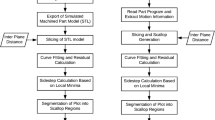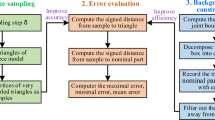Abstract
A numerically controlled (NC) machining verification method is developed based on a formulation for delineating the volume generated by the motion of a cutting tool on the workpiece (stock). The motion of a cutting tool is modeled as a surface undergoing a sweep operation along another geometric entity where machine tool trajectory includes translational and rotational movements. A rank-deficiency condition is imposed on the Jacobian of the sweep to determine the singular surfaces. Singular entities are then intersected to determine sub-entities that may exist on the boundary of the volume. A perturbation method is used to identify the boundary envelope of the material volume to be removed. Numerical examples
illustrating the formulation are presented. Benefits of this method are its ability to depict and visualize the manifold and to compute a value for the volume.
Similar content being viewed by others
References
Wang WP, Wang KK (1986) Geometric modeling for swept volume of moving solids. IEEE Comput Graph Appl 6(12):8
Boussac S, Crosnier A (1996) Swept volumes generated from deformable objects application to NC verification. Proceedings of the 13th IEEE International Conference on Robotics and Automation, Minneapolis, MN, 1996, vol 2, pp 1813–1818
Liu C, Esterling D (1997) Solid modeling of 4-axis wire EDM cut geometry. Comput Aided Des 29(12):803
Chiou JCJ (2004) Accurate tool position for five-axis rule surface machining by swept envelope approach. Comput Aided Des 36(10):967
Lartigue C, Duc E, Affouard A (2003) Tool path deformation in 5-axis flank milling using envelope surface. Comput Aided Des 35(4):375
Roth D, Bedi S, Ismail F, Mann S (2001) Surface swept by a toroidal cutter during 5-axis machining. Comput Aided Des 33(1):57
Blackmore D, Leu MC, Wang LP, Jiang H (1997) Swept volumes: a retrospective and prospective view. Neural Parallel Sci Comput 5:81
Leu MC, Wang L, Blackmore D (1997) Verification program for 5-axis NC machining with general APT tools. Ann CIRP 46(1):419
Voelker HB, Hunt WA (1985) The role of solid modeling in machining process modeling and NC verification. SAE Technical Paper 810195, Warrendale, PA
Menon JP, Voelcker HB (1992) Toward a comprehensive formulation of NC verification as a mathematical and computational problem. Proceedings of the 1992 Winter Annual Meeting of ASME, Anaheim, CA, 1992, vol 59, pp 147–164
Oliver J, Goodman E (1990) Direct dimensional NC verification. Comput Aided Des 22:3
Narvekar AP, Huang Y, Oliver J (1992) Intersection of rays with parametric envelope surfaces representing five-axis NC milling tool swept volumes. Proceedings of the 1992 18th Annual ASME Design Automation Conference, Scottsdale, AZ, 1992, vol 44, pp 223–230
Takata S, Tsai MD, Inui M (1992) A cutting simulation system for machinability evaluation using a workpiece model. Ann CIRP 38:539
Jerard R, Drysdale R (1988) Geometric simulation of numerical control machinery. ASME Comput Eng 2:129
Jerard R, Drysdale R (1991) Methods for geometric modeling, simulation, and spatial verification of NC machining programs. In: Wozny MJ, Turner JU, Pegna J (ed) Product modeling for computer-aided design. North Holland, Amsterdam, pp 1–14
Koren Y, Lin RS (1995) Five-axis surface interpolators. Ann CIRP 44(1):379
Menon JP, Robinson DM (1993) Advanced NC verification via massively parallel raycasting. ASME Manufact Rev 6:141
Oliver JH (1990) Efficient intersection of surface normals with milling tool swept volumes for discrete three-axis NC verification. ASME Des Autom Conf 23(1):159
Liang X, Xiao T, Han X, Ruan JX (1997) Simulation software GNCV of NC verification author affiliation. ICIPS Proceedings of the 1997 IEEE International Conference on Intelligent Processing Systems, Beijing, China, 1997, vol 2, pp 1852–1856
Liu C, Esterling DM, Fontdecaba J, Mosel E (1996) Dimensional verification of NC machining profiles using extended quadtrees. Comput Aided Des 28(11):845
Lee YS (1998) Non-isoparametric tool path planning by machining strip evaluation for 5-axis sculptured surface machining. Comput Aided Des 30(7):559
Lo CC (1999) Efficient cutter-path planning for five-axis surface machining with a flat-end cutter. Comput Aided Des 31(9):557
Chiou CJ, Lee YS (1999) A shape-generating approach for multi-axis machining G-buffer models. Comput Aided Des 31(12):761
Chiou CJ, Lee YS (2002) A machining potential field approach to tool path generation for multi-axis sculptured surface machining. Comput Aided Des 34(5):357
Elber G, Cohen E (1999) A unified approach to verification in 5-axis freeform milling environments. Comput Aided Des 31(13):795
Balasubramaniam M, Laxmiprasad P, Sarma S, Shaikh Z (2000) Generating 5-axis NC roughing paths directly from a tessellated representation. Comput Aided Des 32(4):261
Balasubramaniam M, Ho S, Sarma S, Adachi Y (2002) Generation of collision-free 5-axis tool paths using a haptic surface. Comput Aided Des 34(4):267
Rao A, Sarma R (2000) On local gouging in five-axis sculptured surface machining using flat-end tools. Comput Aided Des 32(7):409
Jensen CG, Red WE, Pi J (2002) Tool selection for five-axis curvature matched machining. Comput Aided Des 34(3):251
Bohez ELJ (2002) Compensating for systematic errors in 5-axis NC machining. Comput Aided Des 34(5):391
Mann S, Bedi S (2002) Generalization of the imprint method to general surfaces of revolution for NC machining. Comput Aided Des 34(5):373
Yoon JH, Pottmann H, Lee YS (2003) Locally optimal cutting positions for 5-axis sculptured surface machining. Comput Aided Des 35(1):69
Bedi S, Mann S, Menzel C (2003) Flank milling with flat end milling cutters. Comput Aided Des 35(3):293
Gray P, Bedi S, Ismail F (2003) Rolling ball method for 5-axis surface machining. Comput Aided Des 35(4):347
Gray P, Ismail F, Bedi S (2004) Graphics-assisted rolling ball method for 5-axis surface machining. Comput Aided Des 36(7):653
Fussell BK, Jerard RB, Hemmett JG (2003) Modeling of cutting geometry and forces for 5-axis sculptured surface machining. Comput Aided Des 35(4):333
Lauwers B, Dejonghe P, Kruth JP (2003) Optimal and collision free tool posture in five-axis machining through the tight integration of tool path generation and machine simulation. Comput Aided Des 35(5):421
Jun CS, Cha K, Lee YS (2003) Optimizing tool orientations for 5-axis machining by configuration-space search method. Comput Aided Des 35(6):549
Bohez ELJ, Minh NTH, Kiatsrithanakorn B, Natasukon P, Huang RY, Son LT (2003) The stencil buffer sweep plane algorithm for 5-axis CNC tool path verification. Comput Aided Des 35(12):1129
Langeron JM, Duc E, Lartigue C, Bourder P (2004) A new format for 5-axis tool path computation, using B-spline curves. Comput Aided Des 36(12):1219–1229
Abdel-Malek K, Yeh H (1997) Geometric representation of the swept volume using Jacobian rank-deficiency conditions. Comput Aided Des 29(6):457
Abdel-Malek K, Yeh HJ, Othman S (1998) Swept volumes, void and boundary identification. Comput Aided Des 30(13):1009
Abdel-Malek K, Yeh HJ (1997) Analytical boundary of the workspace for general 3-DOF mechanisms. Int J Robot Res 16(2):1
Blackmore D, Leu MC, Wang LP (1997) Sweep-envelope differential equation algorithm and its application to NC machining verification. Comput Aided Des 29(9):629
Ahn JC, Kim MS, Lim SB (1997) Approximate general sweep boundary of 2D curved object. Comput Vis Graph Image Process 55:98
Elber G (1997) Global error bounds and amelioration of sweep surfaces. Comput Aided Des 29:441
Ling ZK, Chase T (1996) Generating the swept area of a body undergoing planar motion. ASME J Mech Des 118:221
Sourin A, Pasko A (1996) A function representation for sweeping by a moving solid. IEEE Trans Vis Comput Graph 2:11
Abdel-Malek K, Yeh HJ (1996) Determining intersection curves between surfaces of two solids. Comput Aided Des 28(6/7):539
Author information
Authors and Affiliations
Corresponding author
Rights and permissions
About this article
Cite this article
Yang, J., Abdel-Malek, K. Verification of NC machining processes using swept volumes. Int J Adv Manuf Technol 28, 82–91 (2006). https://doi.org/10.1007/s00170-004-2352-8
Received:
Accepted:
Published:
Issue Date:
DOI: https://doi.org/10.1007/s00170-004-2352-8




